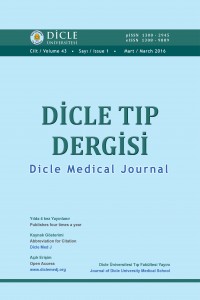Öz
Synthetic cannabinoids (SC) are referred such as ‘Spice’ in Europe, ‘K2’ İn USA, on the other hand ‘Bonzai’ in Turkey. Bonzai has recently popular SC herbal-drug in Turkey which abuse increasingly, not very well known about its complications and neuro-radiological findings in literature. As a result of this it is substantial for radiologist be aware of neuro-radiological findings may be related to Bonzai or Bonzai like SC complications and thought as a differential diagnosis at unknown or indeterminate patient history. In this case report, we presented Bonzai abuse case neuro-radiological findings that computed tomography showed hypodense areas may be related to ischemia, on the other hand magnetic resonance imaging demonstrated at T2 weighted (T2W) and fluid attenuation inversion recovery (FLAIR) sequence hyperintensities in those areas are compatible with vasogenic edema . In addition, corpus callosum splenium has a signal increase at FLAIR sequence and multifocal intraparencymal hematomas has periferally edema are also shown.
Key words: Bonzai, Pres, Rcvs, magnetic resonance imaging
Anahtar Kelimeler
Kaynakça
- Evren C, Bozkurt M. Syntetic Cannabinoids: Crisis of the decade. Düşünen Adam 2013; 26:1-11. Turkish.
- Tamrazi B, Almast J. Your Brain on Drugs: Imaging of drugrelated
- changes in the central nervous system. Neurologic/Head and Neck Imaging. Radiographics 2012;32:701-719.
- Clausen MH, Kneisel S, Szabo B, et al. Acute toxicity due to the confirmed consumption of synthetic cannabinoids: clinical and laboratory findings. Addiction 2012;108:534-544.
- Geibprasert S, Gallucci M, Krings T. Addictive illegal drugs: Structural neuroimaging. Am J Neuroradiol 2010;31:803-808.
- Chen SP, Fuh JL, Wang SJ. Reversible cerebral vasoconstriction
- syndrome: an under-recognized clinical emergency. Ther Adv Neurol Disord 2010;3,161-171.
- Marder CP, Donohue MM, Weinstein JR, et al. Multimodal imaging of reversible cerebral vasoconstriction syndrome:a series of 6 cases. Am J Neuroradiol 2012;33,1403-1410.
Öz
Sentetik kannabinoidler (SK) Avrupa’ da Spice, ABD’ de K2, diğer taraftan Türkiye de Bonzai ismiyle popülerleşmişlerdir. Çağımızın tehlikesi Bonzai, komplikasyonları ve nöroradyolojik bulguları literatürde çok bilinmeyen, son zamanlarda Türkiye’ de popüler olan bir bitkisel kaynaklı sentetik kannabinoid ilaçtır. Bunun sonucu olarak Bonzai veya Bonzai ilişkili komplikasyonlar konusunda radyoloğun nöroradyolojik olarak farkında olması önemlidir. Biz bu olgu sunumunda, bilgisayarlı tomografide iskemi ile ilişkili olabilecek hipodens alanları olan, diğer taraftan magnetik rezonans görüntülemesinde T2 ağırlıklı ve FLAIR sekanslarda vazojenik ödemle uyumlu olduğu düşünülen Bonzai suistimali olgusunun kranial görüntüleme bulgularını sunduk. Ek olarak FLAIR görüntülemede korpus kallozumda sinyal artışı ve kanama odakları izlendi
Anahtar Kelimeler
Kaynakça
- Evren C, Bozkurt M. Syntetic Cannabinoids: Crisis of the decade. Düşünen Adam 2013; 26:1-11. Turkish.
- Tamrazi B, Almast J. Your Brain on Drugs: Imaging of drugrelated
- changes in the central nervous system. Neurologic/Head and Neck Imaging. Radiographics 2012;32:701-719.
- Clausen MH, Kneisel S, Szabo B, et al. Acute toxicity due to the confirmed consumption of synthetic cannabinoids: clinical and laboratory findings. Addiction 2012;108:534-544.
- Geibprasert S, Gallucci M, Krings T. Addictive illegal drugs: Structural neuroimaging. Am J Neuroradiol 2010;31:803-808.
- Chen SP, Fuh JL, Wang SJ. Reversible cerebral vasoconstriction
- syndrome: an under-recognized clinical emergency. Ther Adv Neurol Disord 2010;3,161-171.
- Marder CP, Donohue MM, Weinstein JR, et al. Multimodal imaging of reversible cerebral vasoconstriction syndrome:a series of 6 cases. Am J Neuroradiol 2012;33,1403-1410.
Ayrıntılar
| Birincil Dil | İngilizce |
|---|---|
| Bölüm | Araştırma Yazıları |
| Yazarlar | |
| Yayımlanma Tarihi | 1 Mart 2016 |
| Gönderilme Tarihi | 29 Mart 2016 |
| Yayımlandığı Sayı | Yıl 2016 Cilt: 43 Sayı: 1 |


